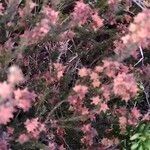Erect, robust shrub up to 1-8 m (6 ft) in favourable conditions. Branches numerous, strong, pubescent or hirsute. Leaves 3-nate, 2-5 mm long, spreading, very variable in shape from linear and sulcate to broad-ovate or oblong and open-backed, especially In shady places, usually rough and hirsute. Flowers 3-nate, terminal on very short branchlets; peduncles less than 1 mm long, pubescent; bracts three, small, median to sub-basal. Sepals usually reaching to the top of the corolla-tube, linear to lanceolate, foliaceous or cartilaginous, often viscid, glabrous. Corolla 1.5-2 mm long, mostly broad-urceolate, sometimes narrower or globose-urceolate, glabrous, viscid, generally pale-rosy to white, rarely red or purplish; lobes more or less spreading, obtuse, 1/4-1/3 the length of the tube. Filaments capillary; anthers included, 1/2-2/3 mm long, lateral, rarely subterminal, oblong-obtuse or semiovate, tapering at the base, smooth, pallid, muticous; pore 1/2 the length of the cell. Ovary depressed-globose, more or less hispid, occasionally glabrous; style shortly exserted; stigma large, peltate or cyathiform.
Erect, robust shrub, 1.0-1.8 m high. Leaves 3-nate, spreading, 2-5 mm long, shape variable, linear and sulcate to broadly ovate or oblong and open-backed, rough and hirsute. Flowers 3-nate, terminal on very short branchlets; bracts 3, small, remote. Calyx sepals reaching top of corolla-tube, linear to lanceolate, foliaceous or cartilaginous, often viscid, glabrous. Corolla 1.5-2.0 mm long, broadly urceolate, glabrous, viscid, white, pale rose, rarely red or purplish; lobes ± spreading, obtuse, 1/3-1/2 length of tube. Filaments capillary; anthers included, 1/2-2/3 mm long, oblong-obtuse or semi-ovate, smooth, pallid, muticous, appendages minute; pore 1/2 length of theca. Ovary depressed-globose, ± hispid; style shortly exserted; stigma large, peltate or cyathiform. Flowering time all year.
Erect shrublet to 1(-1.8) m. Flowers small, urn-shaped to bell-shaped, white, pink or red.

